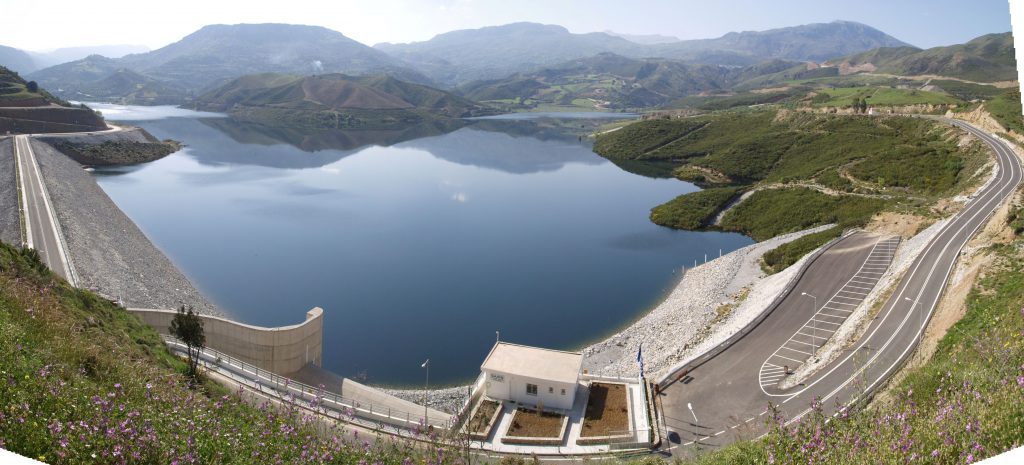The largest hybrid project to produce clean energy in Europe
By TERNA ENERGY at Amari, Crete
The largest hybrid project in Europe and the first of its size and characteristics in Greece, the Hydro Pumped Storage in Amari, Crete, is a model green investment of strategic importance that creates 1,000 new jobs during the construction of the project and at least 100 during operation period.
It creates € 110 million additional revenue for local municipalities and communities over a 25-year period, reduces electricity bill for local residents and protects the area from extreme weather events such as floods.
After completing the investment, the country’s largest island, Crete, redirects its energy future and is led to the era of the highly desired green transition, featuring energy efficiency and eliminating blackout risk. Crete becomes an energy hub of the southeastern Mediterranean, and the country’s environmental footprint improves significantly.

It was not random that the Amari region was selected for the largest hybrid clean energy project in Europe. The site has a unique geophysical terrain that renders it ideal for the station’s development. The area’s mountains with quite an altitude difference, lakes, rivers and reservoirs, coupled with the sun and the wind originating from Sitia’s mountaintops, offer comparative advantages to help Crete play a leading role in the Greek revolution of clean energy, supported by the innovative and environmentally-friendly technology developed by TERNA ENERGY.
The hybrid station is based on the energy utilisation of the Potamoi dam and combines energy produced by two wind farms with an installed capacity of 89.1 MW in the prefecture of Lassithi; a hydroelectric power plant with a capacity of up to 93 MW; and a pump complex of a 140 MW capacity. In this way, a guaranteed 227 MW power in Crete’s system is ensured, covering a significant part of the island’s needs. An equal amount of energy produced by polluting stations that use oil as fuel is thus avoided. In addition, during peak hours, the average production cost of the interconnected system is reduced. Therefore, we can easily claim that the station contributes significantly to battling climate change.
The pump system will be installed underground, therefore, will not create a visual or aesthetic disturbance. It will include three constant speed turbine pumps of 31 MW each and twelve variable speed pumps of 3.2 MW each. In this way, the existing (lower) reservoir of the Amari River Dam gets upgraded, while 450 metres higher up, the upper reservoir with a capacity of about 1.2 million cubic metres is constructed.
The pumping units will be fueled exclusively from the Sitia wind farm without consuming any energy from the network. In this way, the project strengthens the network’s stability even after interconnection, providing high-quality ancillary services and the possibility of mass storage of renewable energy.
Pump-storage stations are natural accumulators for storing and managing electricity. They consist of at least two reservoirs at a different elevation. The water used for the production of electricity directed from the upper reservoir can be pumped back to the upper reservoir with the help of turbines using wind and solar (hybrid) or other forms of energy that the system does not need at that time. The same water can be used again whenever necessary, so when demand in the system is high, the water falls into the lower reservoir, producing hydroelectric energy. In this way, excess energy is temporarily stored to be converted to hydroelectric power when the system needs it, increasing supply and reducing electricity price.
This technology is considered the most economically, competitive and technically mature for storing electricity with a lifespan of up to 50 years. The best alternative technology, accumulators, has a much lower storage capacity, multiple costs, and a lifespan of ten years at most.
In practice, pump-storage is the only strategic way for reliably storing electricity, allowing incorporating a more significant percentage of energy from RES, covering possible system stability issues that are due to the unpredictable nature of RES production. That is why what is considered value-added storage solutions, such as hybrids and pump-storage, is now a priority for Europe.
Most importantly, pump-storage creates jobs in Greece instead of being directed to foreign countries to import, e.g. accumulators.
With the realisation of the € 280 million investment, Crete and the whole country turns to sustainable development, a cornerstone for national and European environmental policy. Local and even scientific employment is enhanced with more than 1,000 jobs for the duration of the project development and with at least 100 permanent ones when the operation is launched. The investment’s domestic added value exceeds 60% and is expected to reach € 170 million.
Several accompanying benefits from the project arise for local communities and Crete in general. For 25 years, the project will produce annual revenues of approximately € 4.6 million for the recipient municipalities of Rethymno, Amari, Sitia and their communities, as well as for the Organisation for Crete’s Development, while consumers will also benefit from reduced electricity bills.
In addition, the hybrid station can fully substitute Crete’s gas turbine units, already in limited operation, and help protect the area from damage caused by extreme weather events such as floods.
In its 25-year course, TERNA ENERGY serves a clear vision: to produce clean energy from Renewable Sources to help prevent climate change for the benefit of the country and its local communities. This vision is realised through all of our people’s commitment to carry out major projects that bring growth and innovation to the country’s electricity system. The hybrid station in Amari, Rethymno, is one of them.